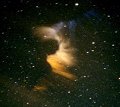|   SPACE WEATHER SPACE WEATHER
Current
Conditions
Solar Wind
velocity: 518.9 km/s
density:8.1 protons/cm3
explanation | more data
Updated: Today at 2245 UT
X-ray Solar Flares
6-hr max: C3 2005 UT Nov19
24-hr: C4 0700 UT Nov19
explanation | more data
Updated: Today at 2245 UT
Daily Sun: 19 Nov '01 
Active region 9704 has developed a delta-class magnetic field that harbors energy for powerful X-class explosions. Image credit: SOHO/MDI
The Far Side of the Sun
This holographic image reveals a possibly large sunspot on the far side of the Sun. Image credit: SOHO/MDI
Sunspot Number: 181
More about sunspots
Updated: 18 Nov 2001
Radio Meteor Rate
24 hr max: 36 per hr
Listen to the Meteor Radar!
Updated: 19 Nov 2001 Interplanetary Mag. Field
Btotal: 10.1 nT
Bz: 2 nT south
explanation | more data
Updated: Today at 2247 UT Coronal Holes:

A small coronal hole is rotating into view near the Sun's SE limb. Image credit: Yohkoh Soft X-ray Telescope.
More about coronal holes
 SPACE WEATHER SPACE WEATHER
NOAA
Forecasts
Solar Flares: Probabilities for a medium-sized (M-class) or a major (X-class) solar flare during the next 24/48 hours are tabulated below.
Updated at 2001 Nov 19 2200 UT
| FLARE | 0-24 hr | 24-48 hr | | CLASS M | 50 % | 50 % | | CLASS X | 10 % | 10 % |
Geomagnetic Storms: Probabilities for significant disturbances in Earth's magnetic field are given for three activity levels: active, minor storm, severe storm
Updated at 2001 Nov 19 2200 UT Mid-latitudes | 0-24 hr | 24-48 hr | | ACTIVE | 25 % | 20 % | | MINOR | 10 % | 05 % | | SEVERE | 05 % | 01 % |
High latitudes | 0-24 hr | 24-48 hr | | ACTIVE | 25 % | 25 % | | MINOR | 10 % | 10 % | | SEVERE | 05 % | 05 % |

Web server provided by
VPS Hosting | What's Up in Space -- 19 Nov 2001
Subscribe to Space Weather News! SOLAR ACTIVITY: Sunspot 9704 has developed a twisted delta-class magnetic field. As a result, the large spot poses a threat for strong Earth-directed explosions as it crosses the face of the Sun during the days ahead.  METEOR STORM: Sky watchers who saw it will never forget it: the 2001 Leonid meteor storm. METEOR STORM: Sky watchers who saw it will never forget it: the 2001 Leonid meteor storm.
The display began on Sunday morning, Nov. 18th, when Earth glided into a dust cloud shed by comet Tempel-Tuttle in 1766. Thousands of meteors per hour rained over North America and Hawaii. Then, on Monday morning Nov. 19th (local time in Asia), it happened again: Earth entered a second cometary debris cloud from Tempel-Tuttle. Preliminary reports from China, Korea and Japan indicate 2,000 to 6,000 meteors per hour -- possibly more -- falling over east Asian countries and Australia. Stay tuned for updates. WEB LINKS: NOAA FORECAST | GLOSSARY | SPACE WEATHER TUTORIAL | LESSON PLANS | BECOME A SUBSCRIBER | 
Potentially Hazardous Asteroids (PHAs) are space rocks larger than approximately 100m that can come closer to Earth than 0.05 AU. None of the known PHAs are on a collision course with our planet, although astronomers are finding new ones all the time.
On 19 Nov 2001 there were 344 known Potentially
Hazardous Asteroids Nov. - Dec. 2001 Earth-asteroid encountersNotes: LD is a "Lunar Distance." 1 LD = 384,401 km, the distance between Earth and the Moon. 1 LD also equals 0.00256 AU. MAG is the visual magnitude of the asteroid on the date of closest approach. 
- PERSEIDS 2001: Perseid watchers on August 12th spotted meteors, auroras, and a disintegrating Russian rocket! [gallery]
- MORNING PLANETS: In July and Aug. 2001, the Moon, Jupiter, Saturn, Venus, and Mercury put on a dazzling early-morning sky show. [gallery]
- ECLIPSE SAFARI: Onlookers cried out in delight on June 21, 2001, when the Moon covered the African Sun, revealing the dazzling corona. [gallery]
- TOTAL LUNAR ECLIPSE: On Jan. 9, 2001, the full Moon glided through Earth's copper-colored shadow. [gallery]
- CHRISTMAS ECLIPSE: Sky watchers across North America enjoyed a partial solar eclipse on Christmas Day 2000 [gallery]
- LEONIDS 2000: Observers around the globe enjoyed three predicted episodes of shooting stars. [gallery]
 Nov. 7 , 2001: What Lies beneath a Sunspot -- Awesome plasma hurricanes were one of the surprises revealed when scientists peered beneath the stormy surface of our star. Oct. 26 , 2001: 'tis the Season for Auroras -- Autumn is a good time to spot Northern Lights. Oct. 17, 2001: Halley's Comet Returns ... in bits and pieces -- The annual Orionid meteor shower peaks on October 21st. Aug. 9, 2001: Horse Flies and Meteors -- Like bugs streaking down the side window of a moving car, long and colorful Perseid Earthgrazers could put on a remarkable show on August 11th. July 27, 2001: Meteorites Don't Pop Corn -- A fireball that dazzled Americans on July 23rd probably didn't scorch any cornfields, contrary to widespread reports. June 12, 2001: The Biggest Explosions in the Solar System -- NASA's HESSI spacecraft aims to unravel an explosive mystery: the origin of solar flares. |

